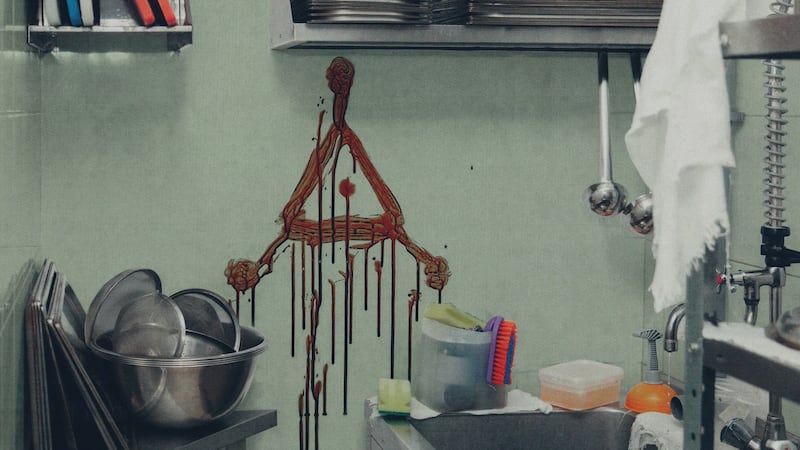Strange Harvest isn’t the first mockumentary to assume a true-crime format; Behind the Mask: The Rise of Leslie Vernon, The Poughkeepsie Tapes, and Lake Mungo pioneered that approach years ago. Nor is it the most insightful look into that particular mode of storytelling; the forthcoming Zodiac Killer Project is a far more intricate and illuminating investigation of the genre’s structure, stratagems, and allure.
Nonetheless, 14 years after he made a splash with the found-footage thriller Grave Encounters, writer/director Stuart Ortiz reconfirms his fondness for faux-verisimilitude with his latest, in theaters Aug. 8, whose tale about a California serial killer with supernatural intentions is filtered through a persuasive verité lens that, however skin-deep, underscores the enduring effectiveness of its non-fiction devices.
From its bookending audio (“There are still so many things we don’t understand about this case, and probably never will”) and its raft of 911 calls set to nighttime aerial shots of the city and suburbs (with accompanying subtitles), to its interviews with police officers in empty warehouses and its collection of home movie, security camera, body cam, and TV news report footage, Strange Harvest looks and sounds just like any of the myriad true-crime offerings available on streaming.
Ortiz has clearly done his homework, and he’s a skillful pantomime. Be it local media chats with witnesses or clips of cops arriving at crime scenes, his disparate material appears genuine, thereby lending the film a veneer of realism that’s preserved all the way to its end and, for those who stick around after the credits, a stinger which intimates that this may be the first chapter in an ongoing saga.
Strange Harvest is led by San Bernardino County homicide detectives Joseph Kirby (Peter Zizzo) and Alexis Taylor (Terri Apple), who recount their experiences with a haunting case that spanned 18 years.
Kirby begins in 2010, when he responded to a welfare-check call about a family of three and found the trio zip-tied and duct-taped to their dining room table, posed as if in prayer, their feet in buckets full of their blood. Above them on the ceiling was a triangular symbol, and it immediately indicated to Kirby that “he’s back.” The person in question, it turns out, is a fiend known as Mr. Shiny, who was eventually linked to three seemingly unrelated 1993-1995 ritualistic murders in Riverside and San Bernardino that were marked by exsanguination and the removal of individual organs.

Ortiz replicates his true-crime forebearers with an eerie precision that gives Strange Harvest a faint Blair Witch-y creepiness. Kirby and Taylor take audiences step-by-step through their meticulous process, along the way expressing horror at Mr. Shiny’s weirdo butchery and sorrow over his victims (including a 12-year-old boy snatched on his walk home from school).
That established template is as enticing as it is in Making a Murderer, The Jinx, or any random Dateline episode, although it’s something of a shallow recreation, intended to generate baseline intrigue and thrills without simultaneously examining its bedrock tricks and tropes. The result is an exercise in duplication that doesn’t go the extra step into auto-critique.
If fundamentally limited in scope, Strange Harvest benefits from a well-plotted narrative that allows it to remain a compelling fake-out—save, that is, for its inclusion of grisly crime-scene photos that no self-respecting true-crime affair would depict. Until the finale, that’s the primary concession Ortiz makes to horror cinema, and it’s a minor blip in an otherwise professionally mounted aesthetic package.
Kirby and Taylor gradually amass baffling clues, such as a textbook page imprinted with the word “Kaliban” and a composite drawing of the killer created from the testimony of a badly burned attack survivor. They also receive letters from Mr. Shiny himself. In them, he playfully writes ominous things like “The great shambler arrives at the gates!” and “Hail Azragor! Hail Drag Aul! U have no idea what I am saying…5 to go and then you’ll know!”
All the while, additional bodies turn up in mortifying fashion, highlighted by a man found in a pool full of leeches whose bite marks resemble Mr. Shiny’s signature triangular sigil.
Strange Harvest is akin to a creepypasta stew of various real (the Zodiac killer) and fictional (The Silence of the Lambs) ingredients, all with a healthy dose of Lovecraftian madness (the name Mr. Shiny, the cosmic conclusion) thrown in for added flavor. Such familiarity makes the proceedings too comfortable; it’s difficult to get unnerved when so much of this has been seen and done before in slightly altered guises.
Still, there’s some spookiness to this sinister story, and it escalates as Kirby and Taylor draw closer to their mark. Deducing their target’s identity, alas, doesn’t necessarily mean they can stop his methodical and purposeful rampage, nor does it make Mr. Shiny any less scary; often wearing a red mask with hollow eye and mouth holes that cause it to resemble a deformed bowling ball, he’s a riveting baddie whose motivations are somewhat open for debate.
Like all good true-crime, Ortiz’s film provides a clear enough picture to suggest a satisfying explanation, all without delivering definitive answers that might cause its out-of-this-world mystery to come crashing back to Earth. Strange Harvest leans heavily on Zizzo and Apple to maintain its façade, and the two actors do a strong job evoking off-the-cuff naturalness even during those amusingly authentic moments when the production requires them to intone a clearly scripted line.
The best compliment one can probably give this mockumentary is that, were a viewer to tune in at the midway point, they likely wouldn’t realize, at least at first, that it was a put-on—a testament to the writer/director’s gift for crafting a credible modern-media sheen.
Because of its central gimmick, Strange Harvest is undoubtedly best suited for home viewing—a fact underscored by a TV-esque opening credit sequence which accurately hews to convention. While it shirks introspection to its detriment, its success as an imitation game attests to the lasting efficacy of its form, as well as implies that the boundaries between the real and the unreal can be, as Lovecraft imagined, perilously thin.
The post This True-Crime Thriller About a Supernatural Serial Killer Has a Twist appeared first on The Daily Beast.




